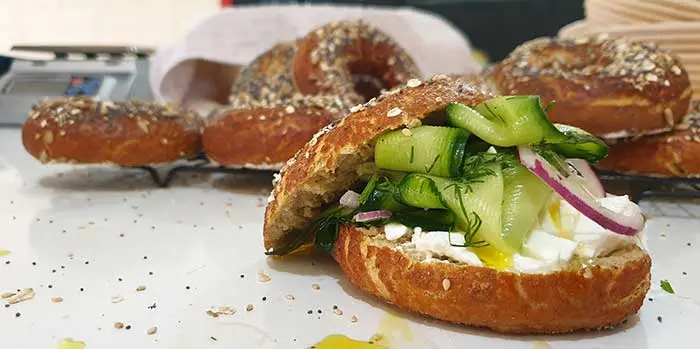
Polish immigrant bakers played a key role in introducing bagels to the world. Their culinary skills and traditions have influenced the development of this iconic bread, with a history dating back to the 13th century.
I remember vaguely, the first time I ate a bagel, but it’s not something that’s synonymous with our Mediterranean culture, That is unless of course, you regard the Ka’ak as a bagel forerunner… I remember the first time I did eat a bagel and thought “wow”, the crisp texture of the outside and the soft, chewy interior with a lightly smoked fish, creamed cheese and fragrant herbed pickles.. but hey, that was in New York … not on our beautiful rock.
So why am I interested in them now… well, everything is cyclical and whilst reading about the history of Bagels because that’s the sort of thing that fills my spare time… I came across the Jerusalem Bagel, and a dear friend of mine asked me to bake him some.
Being a keen baker I was also intrigued by the process, why on earth would you boil dough before baking it? And Lye bath?… What’s that all about?!
So that was it, my curiosity was peaked, and I had to revisit.

Like a lot of my cookery, I had made them before when I was a nipper… but I wasn’t paying attention then and didn’t realise the whole process was as involved as it was.
As a young boy, I was lucky enough to grow up in a very multicultural area, next door to the left I had a Polish family. On the other side, there was a Croatian family and next to them an Italian household… they all had a matriarchial figurehead, and as the cheeky little boy I clearly was, I allowed each of them to adopt me as their own… The Polish lady I found most interesting at the time, I realise now, she was a powerhouse of knowledge, baking, fermenting, distilling they were all part of her skill set and as a young boy, I found her fascinating.
It is relatively well documented, that Polish Bakery is incredibly important in the lineage of culinary skills around Europe and certainly in America. Polish Jewish Bakers imported their skills into kitchens around the world wherever they emigrated. Without these hard-working, skilled Immigrants we wouldn’t have the Poolish, we would probably not have had an introduction to the joys of Caraway in Bread, Chałka, the slightly sweeter Challah bread.. or a million other divine confections…
It was this astonishing matriarch that introduced me to the difference between a Bagel, an Obwarzanek Krakowski and a Bubliks… wow and I was only eight at the time.
According to her excellent new book, “The Bagel: The Surprising History of a Modest Bread”, Maria Balinska shares her theories on its humble beginnings. Shes states that they more than likely were brought to Poland from German Immigrant Bakers who produced the Pretzel and they went on to create the Bagel.
So the joys of the boiled and baked dough ring are nothing new, the Polish bakers have been documented making it from the 13th century when it was made during lent and under the strict governance of the church.

But it does seem to have a forerunner that predates it by about 3,500 years! Egyptians have been making kahk or Ka’ak since the Eighteenth Dynasty of Ancient Egypt, 3500 years ago. Claudia Roden, A Book of Middle Eastern Food. New York: Vintage Books. ISBN 0-394-71948-4. States that a thirteenth-century Middle Eastern culinary text, “Kitab al Wusla il al Habib”, features three recipes of Ka’ak.
So a ringed dough covered in seeds or spices seems pretty ubiquitous, whether its the Ka’ak, The Simit, The Kandil Simidi, the Bagel, Jerusalem Bagel or the Bublik. I have absolutely no doubt boiled dough is divine.
There I was standing next to a large pot of boiling water, and the ever busy Mrs Kamiński was rolling dough into rings and subsequently dropping them into the water, only for about 20 seconds.. but I was sure she had lost her mind. Id only ever seen dough being baked, never boiled, she took the cigarette out of her mouth and told me it was a lye bath [it was the late 70’s and smoking wasn’t frowned upon especially in your own house.] I had no idea what Lye was, but I just accepted it and carried on.
Once she removed the dough rings, they were dried, brushed with egg, christened with sesame seeds and thrust into the wood fire.
That was my first experience with a bagel, so the standard had been set high and until I travelled to New York a good few years later, had never been bettered. In hindsight, I think I was bowled over more by the filling than the actual Bagel itself.
New Yorkers claim it’s the minerals in the water that cause the crisp skin and the chewiness of the dough, just in the same way that Canadians from Montreal claim the honey in their water creates the slight sweetness in their Bagels.
They all have their nuances, and they are all delicious.

At Med.kitchen, our passion lies in crafting exceptional culinary experiences through our online platform. We specialise in sharing a wealth of knowledge via articles, recipes, courses, and online mentoring, aiming to inspire both novice and seasoned chefs alike. Our focus has shifted from private dining to being an online source of gastronomic inspiration, allowing you to explore and refine your culinary skills from the comfort of your home..